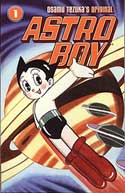 Osamu Tezuka
Osamu Tezuka
Dark Horse Comics ($9.95 each)
by Tosh Berman
On a trip in Osaka, Japan in 1989, I made a point of visiting the Tezuka Museum to see original artwork by Osamu Tezuka, the creator of Astro Boy. Not being able to read Japanese, I became seduced by Tezuka's drawings of a robot boy flying through a 21st-century city that resembles Fritz Lang's Metropolis. Now reading through the series of volumes in translation, I am even more struck by the beauty of Tezuka's bittersweet vision of the future, as well as its horror.
Osamu Tezuka was born in Osaka in 1928. He was raised in Takarazuka, which is also famous for its all-female theatrical troop, and graduated from the Medical Department of Osaka University, but gave up medicine to draw manga, or cartoons. Tezuka is perhaps the first great artist who created manga that could be enjoyed by adults as well as children. Eventually, he started a company that produced the first cartoon TV show in Japan, which was of course Astro Boy.
Tezuka spent his childhood watching films, drawing, and most tellingly, observing insects. He developed a respect for the inner-world of the little creepy-crawlies, and was alarmed when certain insects started to disappear as cities began to dominate the countryside. Since then ecology has been a major theme in his work, second only to the relationship between human beings and robots. Tezuka makes intense observations on the nature of humans and their need to make machines that resemble, if not exactly, themselves.
Astro Boy made his appearance in a Japanese magazine in 1951, six years after Hiroshima and Nagasaki were bombed. In the story, a scientist named Dr. Tenma creates the robot in the likeness of his son Tobio, recently killed in a car accident. In the Doctor's words, "It'll be a Robot unlike any other in the world. It'll be modern science's supreme work of art!" adding touches such as "pleasure circuits to create a happy expression" on Astro Boy's face. Thus is born Tetsuwan Atom—literally "Mighty Atom," though it was translated into English as "Astro Boy," a more mellifluous but ultimately poor choice because the character has nothing to do with outer space.
After a while Dr. Tenma forgets that his replacement son is a robot, except when he notices that the robot is not growing like a little boy. Realizing that this "Tobio" will never grow up, the hateful and disappointed Doctor gives up Astro Boy to a robot circus. Luckily, Professor Ochanomizu sees Tenma's creation at the circus and realizes that this is no ordinary robot. Ochanomizu drags our hero out of robot hell, and through his kindness he teaches the robot boy to fly, speak sixty languages, and best yet, how to sense whether people are good or bad (welcome additions to his 100,000-horse power strength and the machine guns attached to his rear end). He no longer exists as Tobio the robot slave but as Astro Boy, everybody's friend.
Underpinning the Astro Boy stories is the "robot law," which states that the two main rules are "robots exists to make people happy" and "robots shall not injure or kill humans." In the first story in Volume One, Tezuka—who puts himself in the stories to make rather interesting commentary—puts forward the ideas that if we "substitute the word 'science' for 'robot' in the first article of the robot law, I wonder if our science-based civilization has really made people any happier..."
Most of the stories in the series deal with the conflicts between humans and robots. Tezuka's utilization of the concept of robots serves to expose the narcissistic trait in humans: Robots are machines, but somehow we have decided to build these machines after our likeness. Throughout robot literature, artists and authors have made robots to resemble human beings, and what is worse, to possess human qualities. In his work, Tezuka even invented robot "parents" and a little sister so that Astro Boy wouldn't be lonely. But underlying this status-quo family plan is the question: Why must we create machines that look and act human?
Set in 2003, Tezuka's Astro Boy stories are eerily prescient in theme if not in fact. Just as citizens of his fictional future came to the conclusion that life doesn't start only by the sexual act, but can also be created in the laboratory, we must deal with the same realization via cloning. At the heart of the dilemma is the impulse to love what we create, even though a robot made in our image and invested with our passions may really be desired for the purpose of doing all our human dirty work.
With one leg in the human camp and the other in the robot community, Astro Boy is the symbol for a tension that is relevant today. Generally his loyalty is with the robots—how can he not help but not "feel" something for his fellow robots—but the irony is that humans built these feelings within Astro Boy. It is almost heartbreaking to meditate on certain images in Tezuka's manga, such as the round eyes of Astro Boy, looking out onto the world with such sad and useless hope. Similarly the fight scenes in Astro Boy are more sad than angry or heroic or cathartic; the characters already feel regret for destruction and loss of life before entering the battle.
Tezuka's complex vision of 2003 shows us what humanity we humans have lost in the name of progress. His Astro Boy is thus best read as a parable about regaining this humanity, or at the very least, not blowing the second chances that fortune might bring our way.
Click here to purchase Astro Boy, Vol. 1 at your local independent bookstore

Rain Taxi Online Edition, Winter 2002/2003 | © Rain Taxi, Inc. 2002/2003
